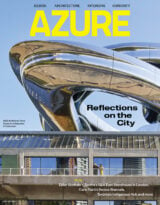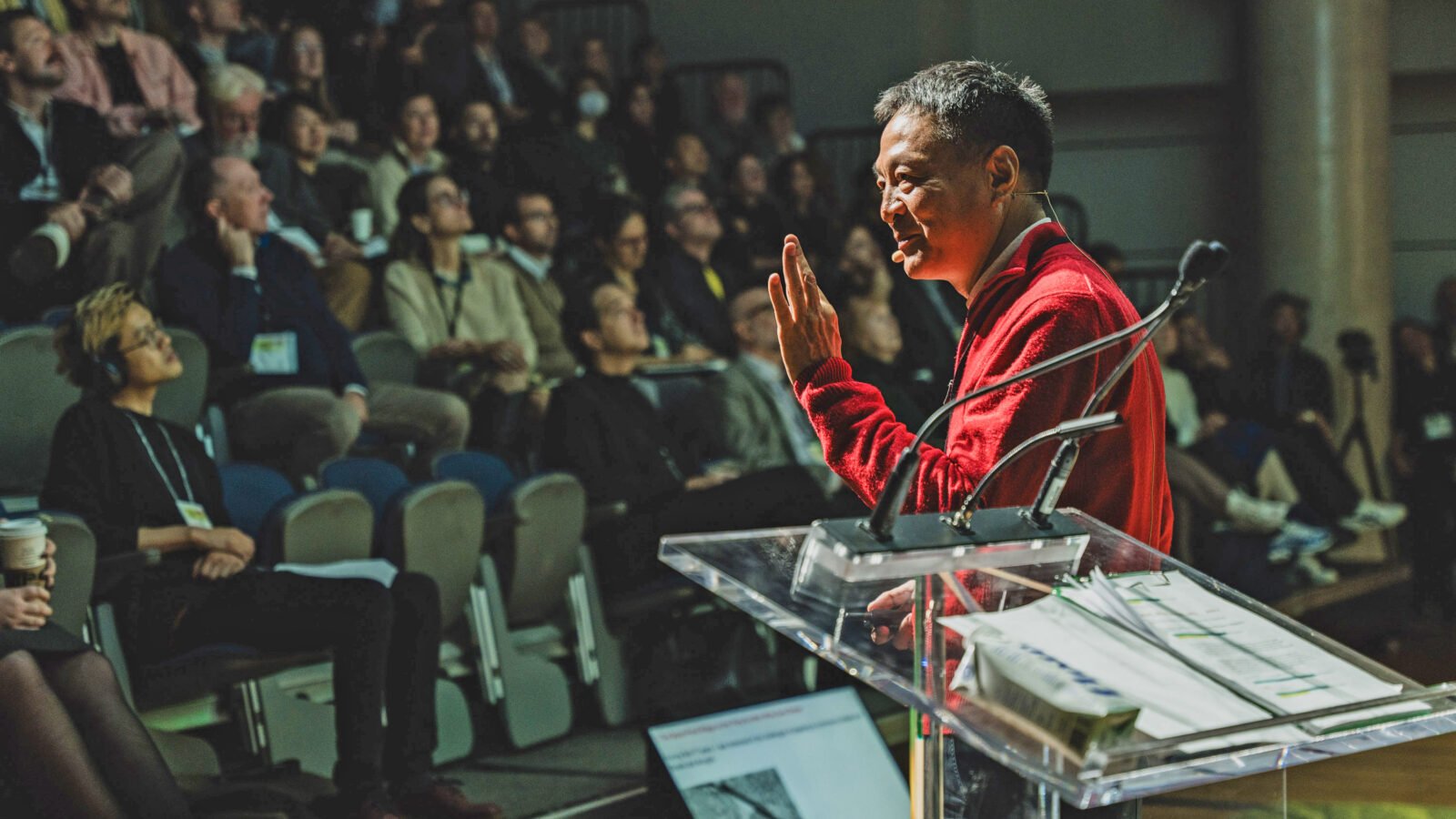
On September 23, 2025, landscape architecture lost a giant. The founder of hugely influential Beijing firm Turenscape and the inventor of the “sponge city” concept of water absorbing, flood resilient landscapes, Kongjian Yu died in a plane crash over Brazil’s Pantanal wetlands, where he was creating a documentary about his work. The incident claimed the lives of all four on board, including filmmakers Luiz Ferraz and Rubens Crispim Junior, and pilot Marcelo Pereira de Barros. At the time of his death, Kongjian Yu was arguably the world’s most influential landscape architect. He was 62.
Born into a farming family in a riverside village just outside the city of Jinhua in 1963, Yu came of age in a rapidly changing China. It is a childhood he recounted at AZURE’s Human/Nature Conference last year, where he delivered a rousing keynote that traced the trajectory of his remarkable career to the Wujiang River of his youth. It was an agrarian vernacular carefully honed over millennia of experience. “We built low weirs for 2,000 years, and the farmers built them only one metre high, never beyond that,” Yu said. “It’s a monsoon climate. The farmers harvested just enough water in the dry season to [serve] the village and irrigate the fields.”
In the summers, he swam in the river, immersed in the water’s crystalline white hue and sweet taste. “People think water doesn’t have colour or flavour, but they’re wrong. It’s full of life,” he told the Human/Nature audience. And when the monsoons came? “We were all getting excited, because it meant we could catch fish right at our doorstep.” It wasn’t entirely without risk. “One year, I fell into the current, which is a very strong flow,” said Yu. “But I survived, because there were so many willow branches and reeds to hang onto; The river was friendly then.” And the resulting pollutants from the storm? They were used as fertilizer. By the time Yu returned home from his university studies in Beijing, however, everything changed. In the 1980s, the water was routed into a new concrete channel, inadvertently transforming the river into a deadly swell. The white, sweet water was replaced by a brown deluge. Dead fish piled up on the shore. “Today, you will see only concrete channels,” said Yu. “And if I fell in there? I would have drowned myself dead.”
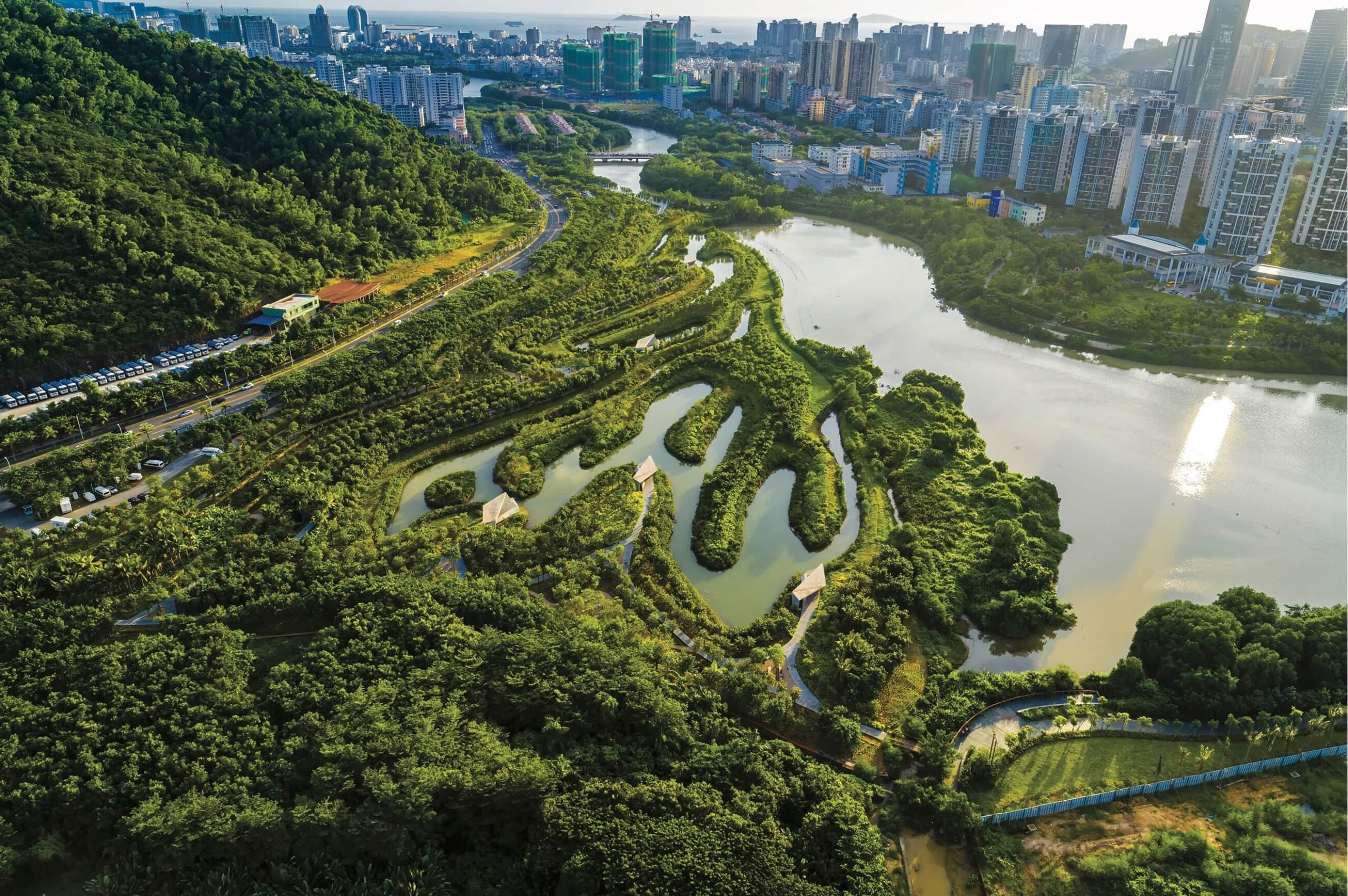
As Yu explained, the whole of his career was shaped by the changing river. The project epitomized a widespread 20th century trend of attempting to control and channel the water to create more predictable conditions. By encasing rivers and shorelines in flood walls, dams and concrete embankments, urban planners sought to maintain predictable year-round conditions, enabling surrounding development and urbanization. From China to Yugoslavia and the United States, the post-war century was built in drainage pipes and concrete walls. It never quite worked. And as global temperatures continue to rise, swelling waters and storm surges overwhelm the hard infrastructures built to contain them with growing regularity.
For Yu, returning home was (more or less literally) a watershed moment. In the 1980s, the Chinese education system did not prioritize landscape architecture as a discipline. Yu then set his sights on Harvard, where he became one of the first Chinese students admitted to the Ivy League institution’s Graduate School of Design. He completed his doctorate in 1995, after studying with the likes of Martha Schwartz, Peter Rowe and Carl Steinitz. There, he honed his vision for a different kind of coastal landscape, one he would later describe as an “eco-utopia built in the basement of Gund Hall.”
The basic premise was always simple. Yu’s “sponge city” translates inspiration from his rural youth into a bold urban paradigm of embracing the flow of water instead of fighting it. In cities across the world, Turenscape built grassy berms, ponds, and terraces, all filled with hydrophilic plants and furnished with public life. Basketball courts, civic centres, playgrounds, walkways and cycling paths cut across — and above — the lush greenery, accented by bold colours and an angular, rhizomatic rhythm that reflected the deconstructivist zeitgeist of Yu’s Harvard tenure.

Yu wasn’t the only one to embrace re-naturalization as a water management strategy; similar ideas date back to Frederick Law Olmsted, not to mention Indigenous societies the world over. Today, the core principles have been widely popularized and are increasingly adopted as best practices. Here in Toronto, Michael Van Valkenburgh’s revitalization of Toronto’s Port Lands is a prime example; a project anchored around the re-naturalization of the mouth of the Don River. But Kongjian Yu and Turenscape pushed the envelope further than anyone. Since its founding in 1998, Yu’s firm has completed over 1,000 projects in 200 cities across Asia. While the global footprint stretches from the 42.3 hectares of Bangkok’s striking Benjakitti Forest Park to Seattle’s compact Hing Hay Park, the vast majority of Turenscape’s ouevre is in urban China.
It is a portfolio of landscape icons, from the sloping terraces of Handan City’s 10-hectare Garden Expo to Huaiyang’s 43-acre Fuxi Cultural Park — the most recent of Turenscape’s many AZ Award-winning projects. Many of them remediate deeply scarred post-industrial sites, transforming shuttered factories and toxic soils into thriving, resilient ecosystems. In Nanchang, for example, the Fish Tail Park uses simple cut-and-fill techniques to recreate ancient Aztec garden systems, recycling the site’s former coal ash dump into a flood-resistant cluster of islets.
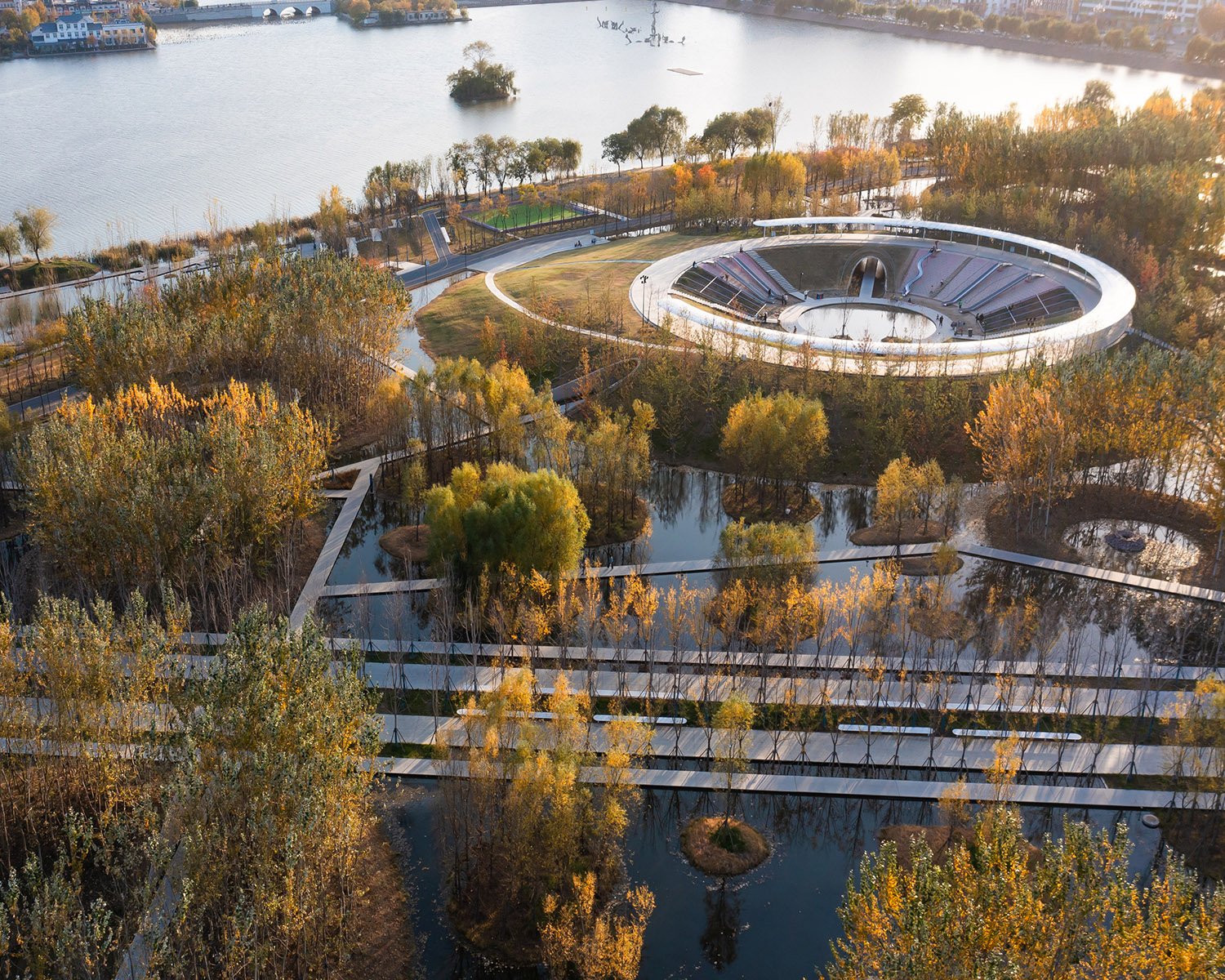
How did they do it? Yu was never shy about the political structure that accelerated his career, while impishly poking fun at the establishment. “In China, this is all pretty simple. You convince the central government, the big man at the top, and everything else follows,” he told the Human/Nature audience, drawing a laugh from the auditorium. Indeed, China is perhaps the only place where a career of Yu’s scope could be logistically and politically feasible to begin with. Yet, he was also a uniquely skilled and persuasive communicator. With colleagues and clients alike, he stressed a “triple bottom line,” articulating tangible ecological, social and economic benefits for every project. “When talking to mayors and governments, I always demonstrate clear benefits and cost savings,” Yu stressed.
Although the sheer footprint of Turenscape’s interventions occasionally bristled against more density-oriented urban real estate logic, the benefits were clear. You don’t have to be an environmentalist — or an aesthete — to see that soft, absorbent green infrastructure is cheaper and more attractive than concrete embankments. Indeed, many of Turenscape’s interventions have become popular public sites, catalyzing nearby development and driving new tourism while clearly improving environmental conditions.
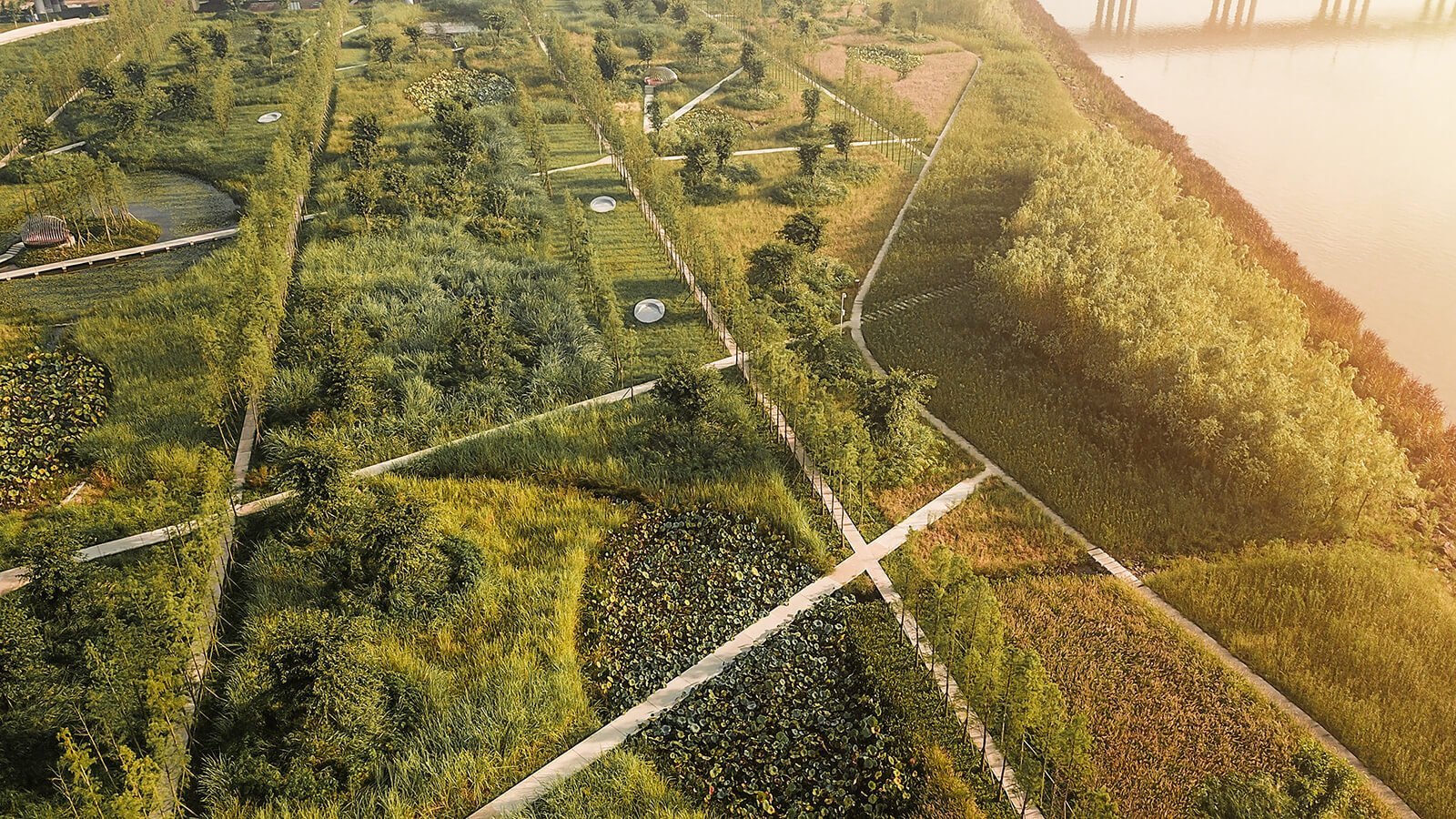
As an educator, Yu founded a new program in landscape architecture at Beijing’s Peking University, vastly expanding the discipline in China. He also travelled the world, lecturing widely with grace and charisma. When we held AZURE’s inaugural Human/Nature conference last year, Kongjian Yu was the first name on our wish list. It felt like a reach. A 2023 winner of the Cornelia Hahn Oberlander International Landscape Architecture Prize — a Pritzker-level honour — Yu was already a living legend, practicing at the absolute peak of global design. In this rarefied realm, speaking engagements are typically filtered through layers of executive assistants and non-disclosure agreements, followed by complex, often months-long negotiations over fees and travel arrangements.
Kongjian Yu was different. After our editor-in-chief, Elizabeth Pagliacolo, sent an introductory email, he responded almost immediately, saying he’d be delighted to come. He didn’t ask questions. In fact, the whole process was so uncommonly seamless that we wondered whether we had the right email address to begin with — whether this was even the real Kongjian Yu. And then, one day in late October, he was here, wearing his trademark red sweater and a ready smile. When he started speaking, the room was under his spell. The energy and conviction was infectious. By the end of the hour, it felt like a better world was not just possible, but practically inevitable.
Sponge Planet: A Tribute to Kongjian Yu
From a farming village in rural China, the late Turenscape founder charted an inspiring path to the summit of global design.
